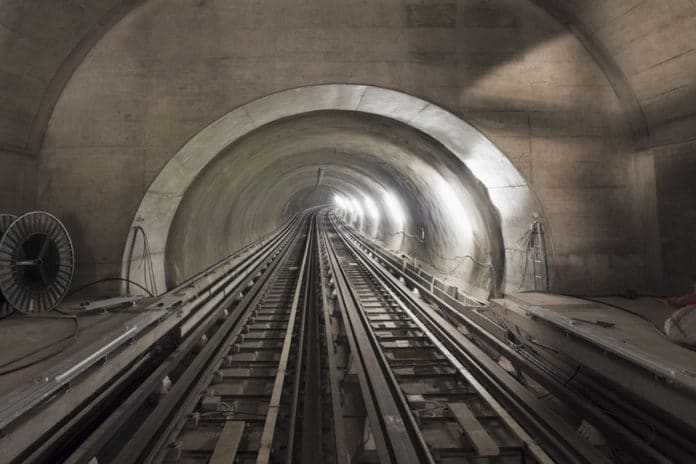Whenever there is a temperature difference, heat transfer occurs. Heat transfer happens in several ways in rail tunnels, for instance, when trains accelerate or brake, they produce heat that warms the surrounding air. That hot air is then mixed with other air in the tunnel and with heat radiating from the ground. Until now, engineers have been unable to accurately calculate the amount of heat present in the air of the tunnel.
Now, a team of researchers at Soil Mechanics Laboratory (LMS) of EPFL has found a solution for this. They have precisely estimated the convection heat transfer coefficient, and this could pave the way for innovative applications involving so-called energy tunnels that can supply energy to build environments.
“Our research shows that fitting the heat-recovery system along 50–60% of the planned route – or 60,000 square meters of tunnel surface area – would cover the heating needs of 1,500 standard 80m2 apartments or as many as 4,000 Minergie-certified energy-efficient units,” explains Margaux Peltier, a scientific assistant at the LMS, whose Master’s research forms the basis of the article.
The system also allows heat to be stored so it can be supplied to homes when needed. “Switching from gas-fired heating would cut the city’s CO2 emissions by two million tons per year,” adds Peltier. Her calculation does not include the savings obtained from metro stations or at the planned rolling-stock depot in the north of the city, which could also benefit from the system.
Temperature naturally stabilizes in underground tunnels, so the excess heat or cold evicted to the surface. The resulting warm air flow is usually seen at the entrance of the metro tunnel. The idea behind the innovation is to harness this surplus warmth, in addition to heat naturally present in the ground.
Just like a refrigerator, the system has plastic pipes which contain heat-transfer fluid, or simply water. These pipes are placed at regular intervals inside the concrete tunnel walls and connected to a heat pump.
The geothermal heat-recovery system would be cheap and energy-efficient to install, according to the researchers. It has a lifespan of between 50 and 100 years, with only the heat pumps having to be replaced every 25 years. Once equipped, heat from the tunnel would cover up to 80% of the heating needs of local apartments throughout winter, with the shortfall preferably coming from other renewable sources.
But what makes geothermal systems like these unique is that they work in summer too. “The tunnel would act like a highly reliable, year-round heating and air-conditioning system,” says Peltier, adding that it would make a real difference to keeping Lausanne’s homes cool during hot weather. The system could even chill the ice rink set to be built in the city’s new Métamorphose eco-district.
The team also tested its model on the future M3 Metro Line in Lausanne. Once complete, the metro line will carry passengers between the city’s train station and the Blécherette district to the north.
“This article underscores the fact that energy-tunnel technology is mature and could be deployed at district-wide scale,” explains LMS head Lyesse Laloui. “It remains to be seen whether Swiss companies are now prepared to take the lead. Globally, we’ve only seen systems like these used on test sections so far.”
Their findings have been published in Applied Thermal Engineering.
